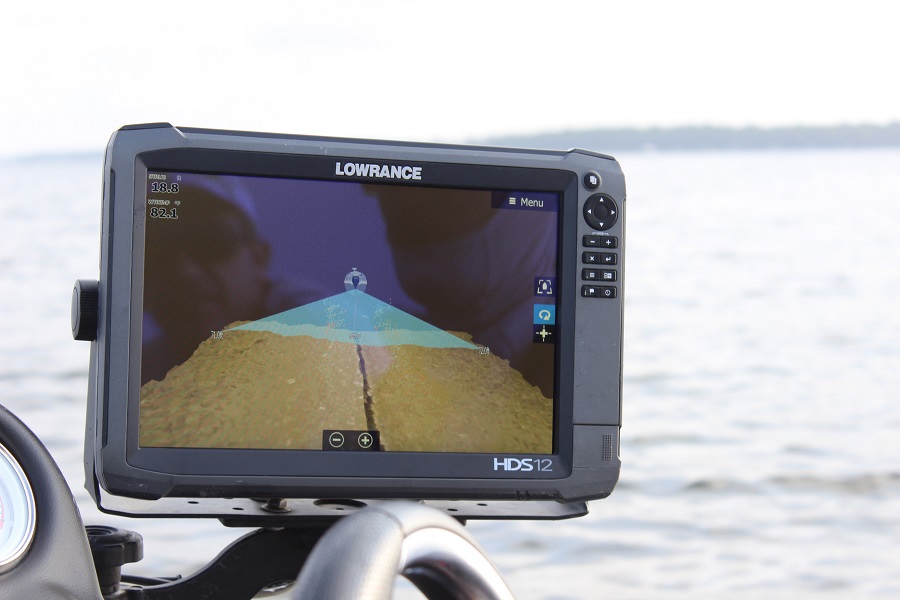
It seems like every year that a new technology is changing how we locate fish. This past year was the Lowrance Structure Scan 3D. Now that it has been on the market and anglers have had the chance to run many benefits are being seen. Elite Series pro Brandon Card has been using it all season long and shares his thoughts on how to get the most of it.
StructureScan 3D
This new technology allows anglers to get a better picture of their underwater surroundings. According to Card, it takes out the guesswork of what is being seen. “It just makes it easier to determine what you are seeing on your standard 2D sonar and DownScan and StructureScan,” he said. “For someone who is not used to those technologies, it will speed up their learning process.”
What Card and others have found out is that they can go back over an area they found with 3D with DownScan or 2D sonar to take a closer look. “It is a great educational tool that will help if you have questions about reading bottom contours. It just makes it easier to visualize and make sense of it all,” he explained.
A Nice Surprise
One of the features Brandon Card likes about the StructureScan 3D has nothing to do with the 3D capabilities. The transducer that is used is the StructureScan 3D Skimmer transducer. This transducer has also improved standard StructureScan.
As good as the 3D can be, Card has found more use and benefit from the enhanced StructureScan. “It has changed how I scan and where I can do it,” he said. “Before, when you were less than 10-feet deep, it was something I would not have tried.”
The image quality has improved and the ability to use the technology is better than the previous two versions of the StructureScan transducer. “I previously stopped using it at around 10-feet, but now it can go much shallower and it will still look clear on the screen,” said the Tennessee pro.
Real Life Experience
All of the best technologies in fishing are useless until they start to pay off with more fish and a better understanding of what is below the surface. Brandon Card quickly found a real life example of how the new transducer on his Lowrance units could help him early this season.
“After the St. John’s River Elite Series event, I stuck around for a few days to try to learn more about the river,” he recalled. “I didn’t do as good as I would like and wanted to do better the next time.”
At this time, his StructureScan 3D was brand new to him. He began exploring the StructureScan feature and was very pleased with the results. “I was able to idle in 4- to 6-feet of water and see far to each side of me to find shell beds, look under docks and even under lily pads,” he said. “I would have never dreamed of using StructureScan like that in Florida; but, it worked.”
What this allows him and others to do is open up the use of StructureScan in other situations. Traditionally anglers only used it in deep, open water as they searched for structure and fish.
Now, according to Card, nothing is out of the question. “One thing I began to do this spring is to use it on long flats in 3- to 4-feet of water to look for stumps and other places during the spawn,” he said. “Before, I would only do it out in the channel and would spend much more time to find those areas in shallow water.”
Settings and Mixing Up the Available Technologies
One of the biggest questions about StructureScan and other technologies is what setting to use. It varies based on the depth according to Card.
“For shallow water, with the new transducer you can go 60 or more feet to each side, when 40 was the max for me before,” he said. Wen fishing deeper than 10-feet, 50 or 60-feet to each side is a good place to start and make sure you can see what is around you.”
Card runs three Lowrance HDS 12s on his Triton. The two at the console are vital as he is searching for fish. He runs both units with split screen views.
“I’ll have one with my map with a Navionics card and the other half will be standard 2D sonar,” he said. “My other one is mounted to the side and will have a split screen between StructureScan and DownScan.” Here he will switch back and forth between the standard StructureScan and the 3D version.
With so many technologies available to us anglers, finding locations to fish is not a problem. By maximizing each of them and getting to know how to use them all together is the best way to catch more fish with the help of your electronics.


 Advertising
Advertising